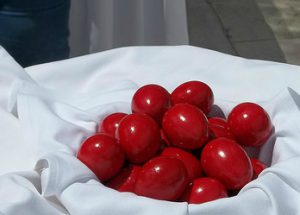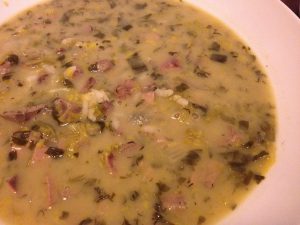Food & Drinks, Traditions
Greek Easter in Kos: A Unique Experience!
Greek Easter is the biggest celebration of the Orthodox Faith.
Easter in Greece has numerous differences from the way it is celebrated to the rest of Europe.
There is no egg hunt
, there is no shoulder of ham; the only thing in common may be chocolate Easter eggs!
But we do have red dyed eggs [ that symbolize the blood of Christ] and a game that we play, where you crack your red egg against someone else. Whoever has the strongest egg [one that doesn’t crack], well, they are the luckiest.
We make sweet cookies that we call “Koulouria” and Easter bread that is twisted and called “Tsoureki”
Holy Week is special with church sermons every evening and is the peak of lent, where you are expected to fast even olive oil not to mention meat, fish and dairy.
Good Friday, is the day that Jesus is mourned. The “Epitaphio”, a wooden replica of the tomb, is decorated with hundred of magnificent flowers and rose petals. It is carried out of the church, by pall bearers in a procession followed by worshipers, who carry list candles or small lanterns, singing beautiful lamentations.
On Holy Saturday, churches around Kos are filled with lilac flowers hand pick from the mountains, called “Labres”.
While the woman prepare for the evening dinner, after mass, young children prepare to celebrate the resurrection of Christ, with a big bang!
Following a custom that dates back many years, they collect big keys, and with the use of rope, tie them with gunpowder and nail them to the wall, through the keyhole. On the evening of the “Anastasi”, they hit the keys on the wall, so hard that the gunpowder causes a bang that makes a lot of noise!
Holy Saturday mass is extra special: just before midnight, all lights in the church are put out, symbolizing the darkness of the tomb.
At the stroke of midnight, the priest comes forward with a lit candle [that has been flown in from Jerusalem] and lights the candle: this light is then spread among the congregation and so on until light fills the whole church. “Christos Anesti” is chanted among the congregation, which means “Christ has resurrected”.
Following the “Anastasi” mass, people head home to have a special meal, “Magiritsa”. It is a lemony tangy soup made up of shallots,
dill and entrails. It is meant to make the transition from fasting easier.
Easter Sunday is a celebration meant to be spent outdoors in the beautiful surroundings of the Greek countryside !
Huge feasts are spread with music and dancing.
For Kos and the rest of the Dodecanese islands, stuffed lamb is on the menu for Easter Sunday. On mainland Greece, whole lambs are roasted on a spit under hot coals.
Lamb is the traditional meal as it symbolizes the sacrifice done by early Jews during their Passover and was then passed on to early Christians.
The lamb is basted in a mixture of oregano, salt, olive oil and lemon juice, brushed on by sprigs of oregano that are tied together and dipped in the marinade to brush on the lamb as it slowly cooks.
The stuffed lamb that is cooked in Kos, is filled either with rice or stale bread along with entrails and various herbs. It is accompanied by roast potatoes.
Various salads and numerous “mezedes” fill the Easter setting, among which is the very popular tzatziki: a yogurt and garlic sauce. It is made of thick Greek yogurt, with grated cucumber, garlic and dill.
Easter on Kos is full of colors, flavors and aromas, rich in Greek traditions. Be sure to enjoy a holiday on Kos during the Greek Easter, it is an experience you will never forget!



Leave a comment